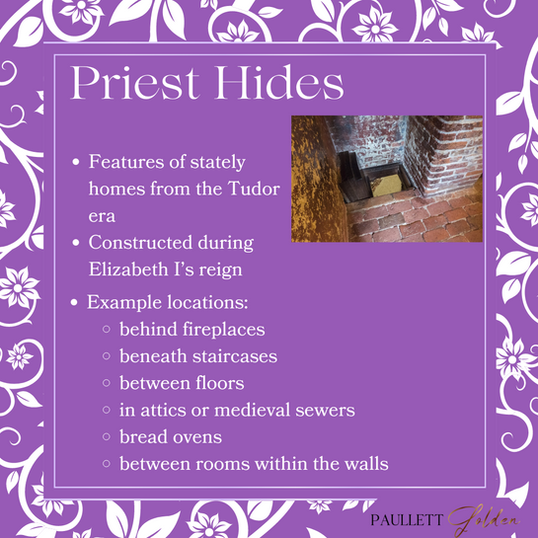Real People. Real Conflict. Real Romance.
Historical Romance
in the style of Jane Austen

Priest Hides
A brief exploration of priest hides within stately homes
Have you read any hist roms featuring a priest hole, either as part of the plot or as a feature of the house?
While priest holes or hides were a feature of Tudor homes, those stately homes during the Georgian era with a long enough history would still have these hidey holes as an estate feature.
Originally, priest holes were built during the reign of Elizabeth I to hide not only Catholic priests, but also Catholic sympathizers, plotters, and monks. Some holes were fairly simple, such as a hidden space behind a wall panel, others more complex with underground passages.
The most common locations were behind fireplaces, beneath staircases, and in attics. These tended to be the first places searched once priest-hunters figured it out, so false priest holes were built in front of real priest holes so the hunters would think they had found an empty hidey hole and not search further. Counting chimneys from the outside of a house and then identifying the matching fireplaces inside would often help hunters identify potential hides of walled-in fireplaces, the unused chimney now serving as the hide itself.
The holes could range from a small room to little more than a cubby with no space in which to maneuver. Depending on circumstances, those hidden could use the hide for the brief moment the hunters arrived or could live in the space for extended periods of time. Some remained trapped inside the holes until the end of their days or suffered from heat stroke or suffocation.
Harvington Hall is a fantastic house to explore when it comes to these hides, as there are seven, the most counted in any one house. It also features some unusual hides, such as the bread oven. Another great house to explore is Coughton Court, which features one of the most intricate hidey holes—a secret floor between two floors and accessible via trapdoor and rope.
Nicholas Owen, called “Little John,” was the mastermind behind many of the most ingenious hides, so he’s a great figure to read more about.
For more examples and details, check out these pages:
https://www.harvingtonhall.co.uk/about/our-story
https://www.nationaltrust.org.uk/visit/houses-buildings/places-to-find-priest-holes
https://www.express.co.uk/news/history/1783478/secret-priest-holes-England
